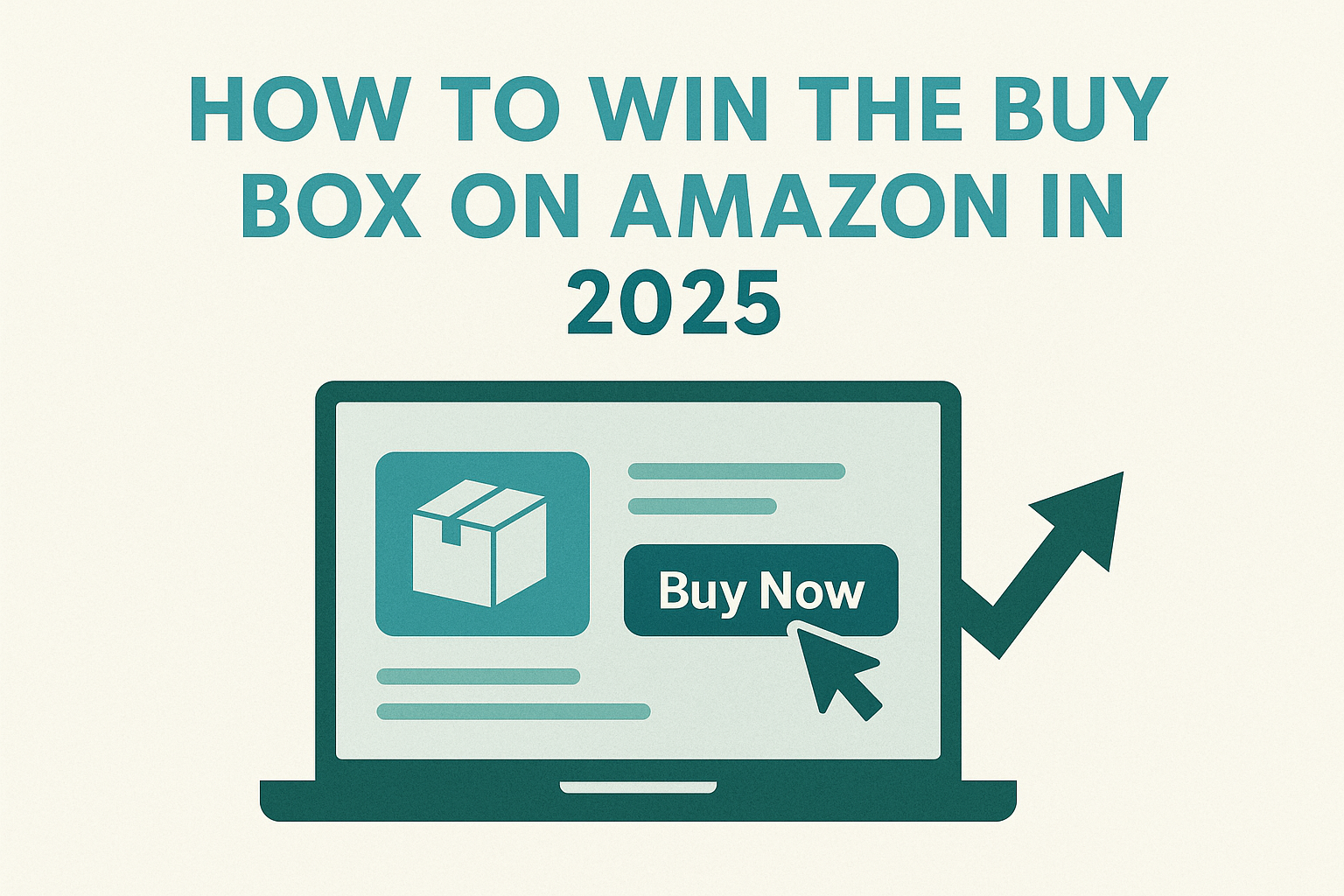Introduction: Why the Buy Box Still Rules in 2025
For Amazon sellers aiming to grow or establish their brand, winning the Buy Box is not just important—it’s essential. Over 80% of all Amazon sales happen through the Buy Box, making it the digital shelf every seller wants to own. But with evolving algorithms, heightened competition, and stricter performance metrics in 2025, securing this prime position requires more than just listing a product.
Amazon’s Buy Box (also called the Featured Offer) is the yellow “Add to Cart” and orange “Buy Now” button that appears on product pages. When multiple sellers offer the same product, Amazon determines which one appears in the Buy Box—typically the seller who delivers the best overall value to the customer.
So how can a new or growing brand consistently win the Buy Box in 2025? The answer lies in understanding the algorithm, analyzing your competitors, and taking data-driven action to optimize every aspect of your offer.
In this guide, we’ll walk you through a comprehensive, step-by-step process for conducting a winning competitor analysis—so you can increase your Buy Box share and stay competitive on Amazon.
What is the Amazon Buy Box (and Why Should You Care)?
Before diving into competitor analysis, it’s important to fully understand what the Buy Box is and how it works.
The Buy Box is Amazon’s way of highlighting the seller most likely to provide the best customer experience. When a shopper clicks “Add to Cart,” they’re usually buying from the seller who holds the Buy Box—whether they realize it or not.
To be eligible for the Buy Box, a seller must:
- Have a Professional Seller account
- Be Buy Box eligible (based on performance metrics)
- Offer new products (not used or refurbished in most categories)
But eligibility doesn’t guarantee visibility. Amazon’s algorithm evaluates many variables—pricing, fulfillment method, shipping time, seller rating, stock availability, and more—to decide who wins the Buy Box at any given moment.
In 2025, the process is even more dynamic, as Amazon gives more weight to fast shipping (especially via FBA), excellent seller metrics, and competitive pricing. Winning requires active monitoring and agile decision-making.
Step 1: Identify Your Top Competitors on Shared Listings
The first step in your Buy Box strategy is identifying who you’re competing against.
If you’re selling a product already listed by other sellers (a common case for resellers or wholesalers), navigate to the product listing and look at the “Other Sellers on Amazon” section. These are your direct competitors for the Buy Box.
Pro Tip: Document your findings in a spreadsheet. Track ASINs, seller names, prices, review counts, and fulfillment methods.
Step 2: Analyze Pricing Strategies in Real Time
Price is one of the most influential factors in the Buy Box algorithm. But it’s not about offering the lowest price—it’s about offering the best value.
Use Amazon’s pricing tools, or third-party software like Helium 10, to:
- Monitor your competitors’ pricing history
- Track how often they adjust their prices
- See if they use automated repricers
- Understand how promotions affect their Buy Box wins
Key metrics to monitor:
- Landed Price (item price + shipping)
- Your price vs. Buy Box winner price
- Time spent in the Buy Box at each price point
In 2025, dynamic pricing is essential. If your competitor is using a repricer and you’re not, you’ll likely lose the Buy Box more often than not.
💡 Don’t race to the bottom. Combine price analysis with value-driven strategies like faster delivery and superior listing content.
Step 3: Examine Fulfillment Methods and Their Impact
Fulfillment is a powerful Buy Box lever. In nearly all cases, Amazon favors Fulfillment by Amazon (FBA) or Seller-Fulfilled Prime (SFP) sellers because they ensure a high-quality delivery experience.
When analyzing competitors, ask:
- Are they using FBA, FBM (Fulfilled by Merchant), or SFP?
- Do their listings display Prime shipping?
- What’s the estimated delivery time?
You can often win the Buy Box even with a slightly higher price if you offer faster or Prime shipping. This is particularly true for mobile shoppers and Prime members, who now represent the majority of Amazon’s customer base.
If your competitors are using FBA and you’re not, that may be the single biggest reason you’re not appearing in the Buy Box.
🔗 Learn how optimized listings contribute to Buy Box wins on our Listing Optimization page.
Step 4: Evaluate Seller Metrics and Reputation
Amazon’s Buy Box algorithm rewards consistent, high-performing sellers. To stay competitive, analyze your competitors’ seller ratings and metrics where visible.
Key indicators to check:
- Seller Feedback Rating (should be 95%+)
- Number of lifetime reviews
- Order Defect Rate
- Cancellation and Late Shipment Rates
Although you can’t see internal metrics like A-to-Z claims or policy violations, consistently low feedback scores or slow responses to reviews are red flags.
To evaluate your own standing, visit Seller Central → Account Health. Amazon provides direct insights into how your performance affects your Buy Box eligibility.
Tip: Set up alerts or use software to track when competitors get negative reviews or suddenly lose the Buy Box due to performance drops.
Step 5: Monitor Stock Levels and Inventory Availability
Inventory availability is a make-or-break factor. If you go out of stock, you lose the Buy Box—instantly. And regaining it after a stockout can be difficult, especially if competitors remain in stock.
When analyzing competitors:
- Use tools like Helium 10 to estimate their stock levels
- Look for gaps in their availability or patterns of stockouts
- Time your promotions when their inventory is low
At the same time, audit your own inventory strategy. Are you using restock alerts? Do you have safety stock for top sellers? Are your FBA shipments arriving on time?
In 2025, proactive inventory management is essential to consistent Buy Box wins.
Step 6: Compare Product Listings and Content Quality
Amazon wants to feature listings that convert. If your product page has poor content—even if your price and delivery are great—you could lose the Buy Box due to lower conversions.
Evaluate:
- Title and bullet point quality
- A+ Content or Enhanced Brand Content
- Product images and video
- Number and quality of reviews
- Q&A section engagement
Use Amazon’s Brand Analytics or a listing grader tool to benchmark your listings against competitors. Often, sellers with optimized listings convert better—allowing them to win the Buy Box even with a higher price.
At Bits & Atoms, we specialize in conversion-focused listing optimization that feeds the Buy Box algorithm and enhances your product’s rank.
Step 7: Track Buy Box Ownership Over Time
Winning the Buy Box isn’t a one-time victory—it’s a constant battle. The Buy Box rotates throughout the day based on price, availability, and performance.
Use tools like Helium 10 to track:
- Buy Box percentage per day/week/month
- Changes in ownership by time of day or day of week
- The effect of pricing or inventory changes on Buy Box share
These insights help you test changes, measure results, and adjust your strategy in real time.
Winning the Buy Box isn’t always about doing everything better—it’s about doing the right things consistently and monitoring your results.
Step 8: Create an Actionable Plan to Improve Your Buy Box Share
Now that you’ve completed your competitor analysis, it’s time to act.
Here’s how to apply your insights:
- Refine your pricing strategy using repricing software to stay competitive without eroding profit.
- Use FBA or SFP for top-selling SKUs to guarantee fast shipping and Prime eligibility.
- Monitor seller performance daily and set up alerts for any metric dips.
- Invest in listing optimization to increase conversion rates and listing quality score.
- Improve review velocity using Amazon-compliant tactics like Vine, post-purchase email follow-ups, or insert cards.
- Never run out of stock—use forecasting tools and reorder thresholds.
- Track Buy Box trends and adapt continuously based on what works.
Winning the Buy Box is a process—not a destination. It’s about continuous improvement based on real data.
Conclusion: Outperform the Competition with Strategic Buy Box Optimization
In 2025, the Amazon Buy Box isn’t just about offering the lowest price—it’s about offering the best value across fulfillment, listing quality, pricing, and performance.
By conducting a thorough, data-driven competitor analysis, new and growing brands can uncover gaps, find opportunities, and build a strategy that wins—consistently.
Whether you’re just starting out or scaling up, owning the Buy Box means owning the customer experience. And that’s the key to long-term growth on Amazon.Ready to take your Buy Box performance to the next level? Book a Call with Bits & Atoms to discuss your strategy.


